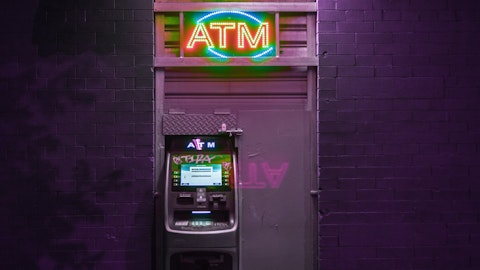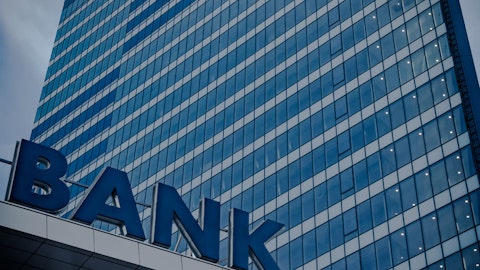Daryl Bible: Yes. Yes, let me take your first question first. So, we really don’t take into account the forward curve when we go through the review that we’re doing. A lot of the properties, like I said earlier, like multifamily is more rate driven than anything else. Their business models are intact. So you have good NOI. I would say, as rates fall, if rates go maybe 100 basis points or more, that could be and probably will be a positive impact for our credit costs. Now it may not flow in as rates actually materialize and have to come through when we’re doing our next review but with that pressure, I think, would alleviate and probably have an impact on the levels that you’re seeing from that perspective. From an office perspective, that part of the sector is a little bit different because it also has some structural challenges.
So if you look at that, that’s going to probably play out more over time. it’s going to be when leases and vacancy rates kind of mature off. We’re just blessed to have a longer time from a maturity perspective, which is great planning from the credit team. The top risk that we have there are embedded in the ratings and reserves that we have. valuations that we have, I think, takes into account the risk. I think we’re around 4.4% right now. So I think we feel good at that. And if you look at the real cover will be when leases mature and you have resizing risk, what’s going to happen at that point. But we have a lot of time for that to play out. I would tell you, if you just look at the Signature transaction, there is a lot of money out on the sidelines that will definitely come in and play and be there.
Right now, there is a difference between bid-ask spreads, but there is money that will come into the market at some point.
Manan Gosalia: Great. Did you say the office reserve was 4.4%?
Daryl Bible: Yes.
Manan Gosalia: Okay. So did the reserve build come somewhere else in the portfolio because I know you built reserves this quarter?
Daryl Bible: We did. I would say reserve builds were mainly driven by the increase in criticized. If you look at our page that we have in the slide deck, the actual office criticized numbers actually fell. Our increases in criticized were in healthcare and multifamily and in hotel. And those are really ones driving the increase. That was probably two-thirds of the increase. The other third was due to the loan growth that we had, which was C&I and consumer loans. So you can kind of see that the build wasn’t that large for the increases that we had. We just really don’t feel we have a lot of loss component because of the loan-to-value ratios that we have and the collateral that we have on those transactions.
Manan Gosalia: Got it. Thank you.
Daryl Bible: Yes.
Operator: And we have our next question from John Pancari with Evercore ISI.
John Pancari: Good morning. Just on the – just back to the reserve. I know you cited that it did account for current real estate valuations and changes there. What – and I know you gave us the LTVs, you cited a few of them. Are they refreshed LTVs? And if not, what type of valuation declines are you seeing in your – as you work through the office portfolio specifically?
Daryl Bible: Yes. So when we have done these reviews, I would say we have about 60% of the CRE portfolio. That’s been a very thorough review. Obviously, we’re picking the larger one to ones that are in larger cities that might have more risk from a valuation decline. We’re being probably on average about a 20% decrease in valuations. Our valuations are probably current within the last year or so. So we feel really good with that. We continue to have reviews every quarter. And continue to be very thorough on how we’re looking at that. But I think the reserves we have today, I feel pretty good about it.
John Pancari: Okay. Thank you. And one more just on that, if I could, on the criticized scrub that you did. Is that – was that just that? Was that more of a scrub of the portfolio. It sounds like the way you described it, it was. And if so, could – do you expect less of an increase in criticized assets and related reserve build from this level?
Daryl Bible: John, I would love to tell you that this is the peak of our criticized. We have to finish up what we did. The majority of our construction loans, we have a little bit more construction loans to do this next quarter. And we’re always subject to getting more information in as we get new financials and new vacancy information and all that. But I feel pretty good that we did a very thorough review of what we have out there. We really looked at all the spots that we thought. We’d have the most risk and really took that into account. But I can’t here tell you today that we’re at the top at some point, hopefully, we will be able to say that.
John Pancari: Great. Alright. Thanks, Daryl.
Operator: And we have our next question from Ebrahim Poonawala with Bank of America.
Ebrahim Poonawala: Good morning, Daryl.
Daryl Bible: Good morning.
Ebrahim Poonawala: So I guess just on this criticized, nonaccruals on credit in general, given the work you’ve done, I’m sorry if I missed this, like should we expect – so far, the growth in criticized has not reflected in – or been sort of translated into non-accruals. Should we and expect that to change as you see some of your customers all feel more pressure given just the lagged impact of the rate cycle? Or could we still see non-accruals trend lower? And then what drives criticized lower from where we are today? Is it just time and maturity of these loans? Or could we see a pretty decent decline over the coming quarters?





